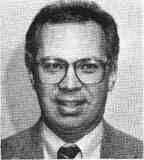
|
BRIDGE CONCERNS
By WILLIAM T. SUNLEY, Engineer of Local Roads and Streets
Illinois Department of Transportation
Credits to: Richard Mochel, Local Bridge Engineer
|
All bridges open to public travel must be inspected
at least every two years. This is a requirement of the
National Bridge Inspection Standards (NBIS). The
Federal Highway Administration (FHWA) is charged
with the enforcement of the NBIS and is very interested
in the states' efforts to assure inspection and maintenance of structures in a serviceable condition.
Illinois has been very active in the effort to make
bridges safe. Inventory, inspection, maintenance, repair, rehabilitation and replacement are all words associated with bridges. To get the job done requires active
participation of many state and local agency employees. With all the new emphasis on specialized inspections and follow-up, even more time and effort will
be needed to get the bridge inspection job done.
The following is a list of the various types of inspections required.
Biennial Inspections — All 17,000 local agency
bridges in Illinois must be inspected at least every two
years, as required by the National Bridge Inspection
Standards (NBIS). Inspections must be performed by
qualified inspectors and the results must be reported to
the IDOT District office for inclusion in the Illinois
Structure Inventory System (ISIS).
Underwater Inspections — This inspection requirement for bridges was emphasized in the latest
revision to the NBIS. Details are contained in the Bureau of Local Roads and Streets Circular Letter 89-3,
dated January 23, 1989 (Circular letters referenced in
this article are policy and procedures letters sent to
municipal and county highway agencies as well as consultants). Inspection procedures are provided in Circular Letter 89-41 dated November 30, 1989. Records
indicate that about 129 bridges are included in this
group. Circular Letter 90-31, dated October 12, 1990
was issued as a reminder that all inspections must be
completed and the data entered in the ISIS by January
1, 1991. To date 91 bridges have been completed. Additional effort is needed to attain full compliance.
Fracture Critical Inspections — Revisions to NBIS
adopted in 1988 require that all fracture critical
members of bridges be inspected at regular intervals.
Each affected bridge must be identified and inspected
by January 1, 1992. Guidelines and other information
regarding this specialized inspection are contained in
Circular Letter 90-25, dated August 17. 1990. About
1, 133 structures fit into this category. To date, 20% have
been inspected.
Scour Evaluation — FHWA, through a Technical
Advisory entitled "Scour at Bridges", requires that all
bridges over water be evaluated for scour. This affects
14, 000 existing bridges in Illinois and those being designed. We met with FHWA, county and municipal
officials to work out an implementation plan, and Circular Letter 91-3, dated January 25, 1991 was issued to
address bridge scour screening, evaluation and design.
In response to subsequent local agency concerns, the
scour screening guidelines were revised to relax and
clarify the requirements of the screening. These revisions were issued by Circular Letter 91-8 on June 7, 1991
which supersedes Circular Letter 91-3. Local agency
structures must be screened to determine the potential
for scour and this screening must be completed by
December 1, 1991.
This office has ongoing programs to train and assist
the local agencies in developing qualified bridge inspectors. We offer a two week inspector training class
that qualifies individuals with five years experience to
be certified bridge inspectors. A courst to train inspectors in fracture critical inspections has been offered
four times in Illinois. One day training in bridge inspection and bridge repair is also offered annually to update
individuals on the latest methods of inspection and
repair.
Bridge concerns are all around us and the 1990s will
see more emphasis on this important issue. If you
haven't trained employees to be qualified inspectors,
sign up for the courses at the first opportunity. If you
don't have the staff to do the inspections, expecially the
specialized ones, then consider hiring a qualified consultant to perform the work. The Bridge Unit in the
Bureau of Local Roads and Streets also offers support in
the rating of structures, so call this office if you have
bridges that require rating. If you have any questions
regarding bridges call Rich Mochel, Local Bridge Engineer at (217) 782-5928 for assistance. •
July 1991 / Illinois Municipal Review / Page 9